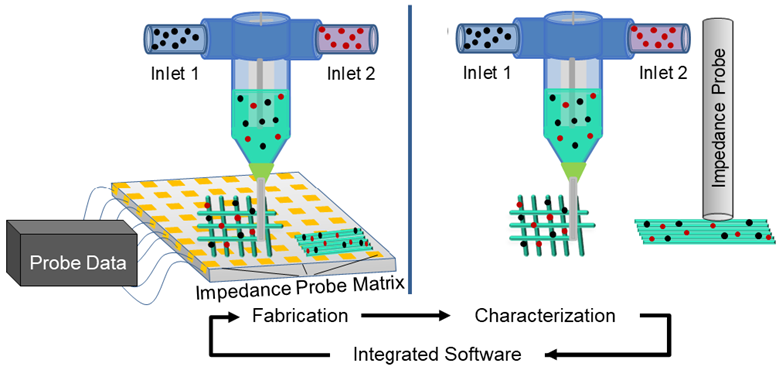Polymer materials formulation and optimization has been generally limited to mixing by hand, as polymers have a wide range of viscosities. A high throughput approach is therefore needed to enable faster screening of polymers optimized for targeted applications. There currently exists systems that mix multi-materials with disparate viscosities. If these systems are integrated with an in-situ characterization capability combined with machine learning experimental planning systems, an all-in-one polymer optimization and screening platform could be developed that can facilitate high-throughput materials development.
The Studying-Polymers-On a-Chip (SPOC) platform has three major components:
(1) active-mixing direct-ink-write
(2) in situ characterization substrates or probes
(3) active learning experimental planning system.
Active-mixing direct ink write (DIW) additive manufacturing enable mixing of materials with highly disparate viscosities, from liquids to pastes. By coupling this mixing system with in-situ characterization methods with machine learning experimental planning systems, LLNL researchers developed an automated platform for materials discovery and optimization.
Machine learning models take the data from the DIW AM prints and use it to dictate the next batch of films to be printed, homing in on the formulation that achieves the best desired property required for the target application. While active mixing DIW has already been developed [Harvard’s U.S. Patent No 10,071,350], the novelty of this LLNL invention is the integrated system of characterization capabilities, machine learning, and experimental planner, making it a closed-loop polymer screening system.
- Value Proposition: High-throughput (scale-up) polymer materials development
- System Flexibility: Capable of handling complex hybrid formulations, including, but not limited to, solvents, monomers, oligomers, polymers, and additives. Additives can be liquid or solid.
- Can vary the material composition during the printing process.
- Automated high-throughput screening of increased ionic conductivity polymer electrolytes
- Optimization of 3D printing inks
- Polymer materials optimization and screening
Current stage of technology development:
TRL ☐ 0-2 ☒ 3-5 ☐ 5-9
LLNL has filed for patent protection on this invention.
U.S. Patent Application No. 2024/0091808 High Throughput Materials Screening published 3/21/2024
U.S. Patent Application No. 2024/0096454 High Throughput Materials Screening published 3/21/2024


